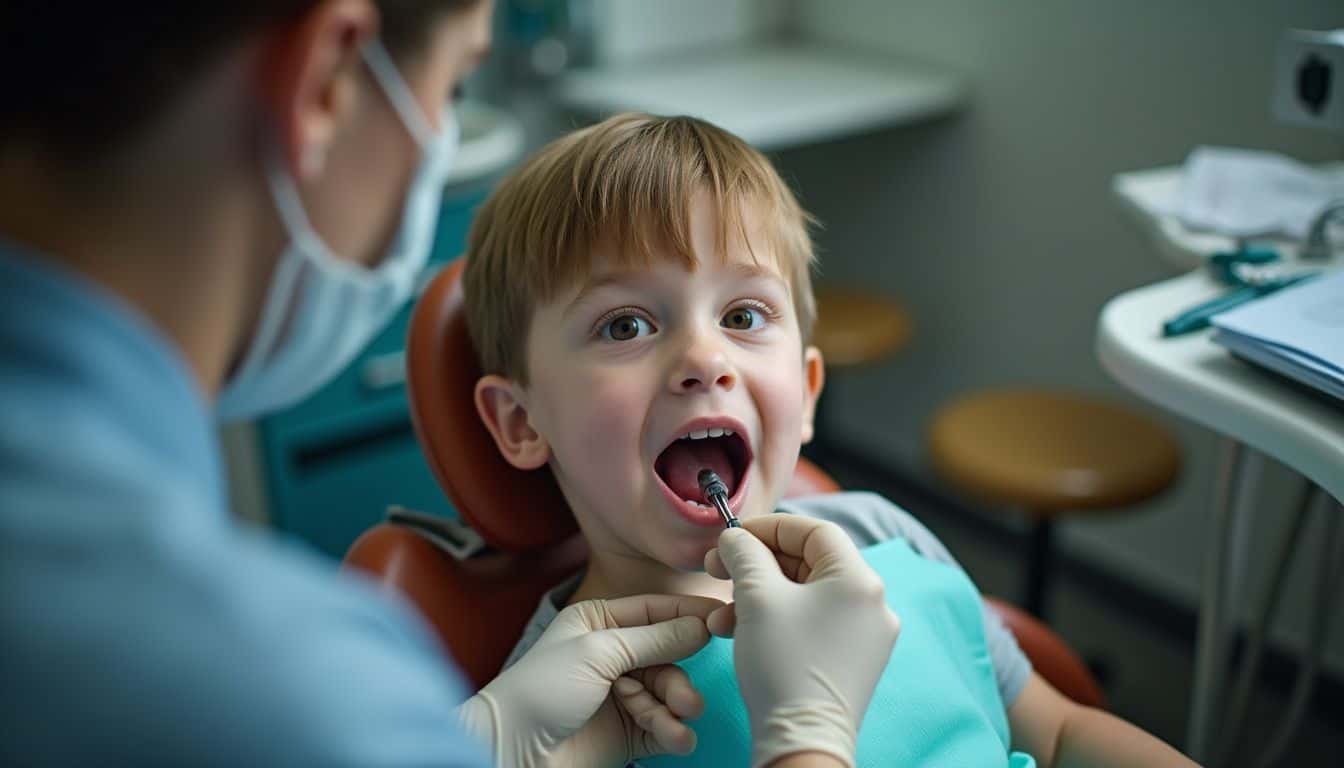Ever find yourself worrying about your child’s smile or getting lost in the debate between interceptive orthodontic vs. comprehensive treatments? You’re definitely not the only one.
It can feel confusing, but catching issues early with interceptive orthodontics can make a huge difference. It’s designed to spot and help fix concerns like overjet, open bites, and crossbites in kids before they become bigger problems.
I’m going to walk you through both approaches and break down seven key differences. My goal is to help you feel confident in picking the best strategy for your family’s dental health and well-being. Let’s get into the inside scoop on braces, tooth eruption, and even self-esteem!
Key Takeaways
Interceptive orthodontics often starts between ages 6 to 10 and uses tools like palatal expanders and space maintainers to guide jaw growth before all permanent teeth have come in. This can often shorten later treatment and potentially lower long-term costs.
Comprehensive orthodontics typically begins after most permanent teeth have erupted (around age 10+), using braces, clear aligners, or surgical options. Treatment can last up to 2 years or more, with studies showing significant improvements in alignment and bite.
Early detection with interceptive care can help prevent severe malocclusions, reducing the need for future tooth extractions or surgery. Less invasive options like habit appliances and palatal expanders work with a child’s natural growth for simpler solutions.
Comprehensive care is designed to perfect both function and aesthetics. Traditional braces have success rates of around 88% to 90% in achieving the desired occlusion, while clear aligners have a similar success rate for mild to moderate cases.
Choosing the right path involves considering your child’s age, the severity of the issue, and insurance rules. A professional consultation with an orthodontist is key to creating a personalized plan for the best results.
Table of Contents
What is Interceptive Orthodontics?

Interceptive orthodontics is all about stepping in early to guide a child’s dental growth. Think of it as proactive care. Dentists use special tools to help fix bite issues before they have a chance to get worse.
What is the definition and purpose of interceptive orthodontics?
This early approach, also known as Phase I treatment, targets dental problems in young children, often when they still have a mix of baby and permanent teeth. The American Association of Orthodontists (AAO) recommends a child’s first checkup by age 7. This timing allows an orthodontist to spot potential issues as the first permanent molars appear.
The main goal is to guide the jaw’s growth and make sure permanent teeth have enough room to come in properly. By taking advantage of a child’s natural jaw growth, treatments become more effective and often less invasive.
Acting early can significantly shorten the time a child might need braces later on, sometimes reducing it to just 6 to 18 months. It can also help families avoid more complex procedures and save money by addressing major malocclusions before they worsen.
If you’re curious, you can find great examples of how orthodontists correct growth-related issues with this approach. Next, let’s look at what makes this method unique.
What are the key characteristics of interceptive orthodontics?
Interceptive orthodontics typically begins when a child is between five and ten years old, a time when they still have some of their baby teeth. The treatment uses specialized appliances to guide oral development and tackle common problems head-on.
Some of the most common tools include:
- Habit Appliances: These are designed to help break habits like thumb-sucking or tongue thrust that can push teeth out of alignment.
- Palatal Expanders: This device gently widens the upper jaw to create more space for crowded teeth and can help correct a crossbite.
- Space Maintainers: If a baby tooth is lost too early, these small devices hold the spot open to ensure the permanent tooth can erupt properly without neighbors drifting into the empty space.
“Small changes made early can save big headaches for families down the road.”
The focus is on early intervention rather than waiting for all the adult teeth to be in place. This means treatments are often shorter, less uncomfortable, and not as invasive as comprehensive orthodontics or jaw surgery. My own patients have been amazed at how a simple appliance helped them avoid the need for more complex treatment later.
Next up, let’s see how comprehensive orthodontics offers a different approach.
What is Comprehensive Orthodontics?

Comprehensive orthodontics is what most people picture when they think of braces. It’s the process of fixing dental misalignments using tools like traditional braces and clear aligners like Invisalign, all while keeping an eye on your overall oral health.
What is the definition and purpose of comprehensive orthodontics?
Comprehensive orthodontics is a full-scale treatment that addresses dental misalignments and bite issues after most or all permanent teeth are in, usually for kids age 10 or older. The goal is to create a healthy, beautiful smile while also improving how your teeth function for daily activities like chewing and speaking.
This approach uses a variety of tools to get the job done, including:
- Metal or Ceramic Braces: The gold standard for correcting a wide range of issues.
- Clear Aligners: Brands like Invisalign offer a more discreet way to straighten teeth.
- Surgical Options: For severe cases, a maxillofacial surgeon may be involved to correct jaw discrepancies.
This treatment can handle complex problems that early intervention alone can’t fix. Because it addresses everything at once, the process can take longer than interceptive care, but it provides a complete solution for long-term dental health and confidence.
What are the key characteristics of comprehensive orthodontics?
Comprehensive orthodontics (CO) is available for children, teens, and adults, generally starting after age 10 once the permanent teeth have come in. The tween and teen years, especially between 11 and 14, are often an ideal time for this treatment because we can work with their natural growth to help correct the bite.
Modern orthodontics uses advanced technology for better results. Instead of messy molds, many offices now use digital intraoral scanners to create precise 3D images of your teeth. This leads to more accurate planning and better-fitting appliances. A recent systematic review found that the average treatment duration for comprehensive orthodontics is about 25 months.
Studies consistently show that CO delivers significant improvements. It’s measured with tools like the Peer Assessment Rating (PAR) score, where comprehensive treatment provides a higher average improvement than interceptive care alone. The long-term results create a smile that not only looks great but functions correctly, too.
Key Differences Between Interceptive and Comprehensive Orthodontics

These two approaches are designed for different stages of life, each with its own timing, duration, and specific goals. Understanding these differences can help you and your orthodontist decide on the best plan for your child’s needs.
Age of Treatment
The biggest difference is timing. Interceptive orthodontics, or Phase I, is all about early action, typically starting between the ages of 7 and 10. In fact, the American Association of Orthodontists recommends every child get an orthodontic check-up no later than age 7. My own daughter first saw an orthodontist at seven, and it gave us such peace of mind to have a plan in place early.
Comprehensive orthodontics, on the other hand, usually begins after most permanent teeth have erupted, which is typically around age 10 or older. For teens, especially those between 11 and 14, this is a great window to address more severe overbites or other complex issues while their jaw is still growing.
“My son’s smile changed quickly after his dentist acted fast at age eight,” shared local mom Alicia H., “and now he skips the more intense braces his big sister endured.”
No matter the path, early detection is always a win for a successful outcome.
Duration of Treatment
The length of treatment also varies quite a bit. Interceptive, or Phase I, treatments are often much shorter. Many kids finish with limited braces or appliances in about 6 to 18 months. My daughter wore her first appliance for just under a year, which made the whole experience feel manageable.
Comprehensive care for older kids and teens naturally takes longer since it’s correcting the final position of all the permanent teeth. Most comprehensive treatments are completed in 18 to 24 months. A large-scale review confirmed this, finding the average treatment time to be just under 25 months. Even if a child has Phase I treatment, they might still need a second phase of comprehensive care later, but the early work can often shorten the total time they spend in braces.
Goals of Treatment
The goals of each treatment are tailored to the child’s developmental stage. Early orthodontic care focuses on guiding jaw growth and making sure there’s enough room for all the permanent teeth to come in. This proactive approach can reduce the need for tooth extractions later and prevent minor issues from becoming major ones.
Comprehensive treatment has a broader goal, aiming to perfect both the appearance and the function of the smile. It’s about getting every tooth in its ideal spot, ensuring the bite is healthy, and making teeth easier to clean. A proper bite helps distribute force evenly, which reduces wear and tear on your teeth over time. By focusing on both health and aesthetics, comprehensive plans provide a complete, long-lasting solution.
Benefits of Interceptive Orthodontics

Giving your child an early start on their dental health can be a game-changer. Spotting problems early can save you money and can sometimes even help kids avoid the need for full braces later on.
How does early detection of issues help in interceptive orthodontics?
Catching malocclusions (bad bites) by age 7 gives an orthodontist a major head start. An early evaluation allows them to identify issues with jaw growth or tooth eruption before all the adult teeth have even arrived. Treating problems like irregular jaw development or blocked teeth at this stage can prevent bigger, more complex issues from developing.
A small fix in childhood can mean avoiding tooth extractions or even surgery as a teen. Parents often love that this early action can lead to lower overall costs and fewer hours spent in the dental chair down the road. As pediatric dentist Dr. Emily Tran says, “Catch small problems early, and you dodge big headaches later.”
How does interceptive orthodontics prevent severe dental problems?
By correcting issues like misalignment and crowding early on, interceptive orthodontics significantly cuts down the risk of tooth decay and gum disease, since straight teeth are easier to clean. The ages between 5 and 11 are a sweet spot for guiding dental growth. Pediatric dentists and orthodontists can spot things like improper bites or crooked teeth and intervene before they get worse.
In my own family, we noticed my niece’s crowded front teeth when she was six. Her dentist recommended a small palate expander. That simple step made it so her future braces treatment would be much simpler and faster. It also saved her parents a good bit of money compared to what it would have cost if they had waited. For more on how this connects to overall well-being, check out this story about oral health for men.
What are the less invasive treatment options in interceptive orthodontics?
One of the best things about early treatment is that the options are often gentle and kid-friendly. Instead of a full set of braces, an orthodontist might use one of these tools.
- Space Maintainers: These are amazing for holding a space open if a baby tooth is lost too soon, preventing future crowding.
- Habit Appliances: These devices can help a child stop thumb-sucking or tongue-thrusting habits that could otherwise affect their dental growth.
- Palatal Expanders: Many children find these much less intimidating than full braces. They work to widen the upper jaw, which can create the space needed for adult teeth to fit properly.
These less invasive options often turn what could be complex issues into simple fixes, taking advantage of a child’s natural growth to achieve great results.
Benefits of Comprehensive Orthodontics
Braces and clear aligners do more than just straighten teeth, they can boost confidence and improve how your bite functions. Let’s look at how this approach can transform a smile.
How does comprehensive orthodontics correct dental issues?
Comprehensive orthodontics is the all-in-one solution for correcting crooked teeth and bite problems after most of the adult teeth have arrived, usually after age 10. Orthodontists use a variety of tools, like metal braces, ceramic braces, or clear aligners, to gradually and precisely move teeth into their ideal positions.
During the teenage years, an orthodontist can use the body’s natural bone growth to help make significant bite corrections. Even in severe cases that might require jaw surgery, it’s often combined with braces to achieve the best possible result. This approach delivers lasting changes by addressing every dental concern in one focused phase, not just fixing a single problem spot.
How does comprehensive orthodontics improve aesthetics and functionality?
Straightening teeth with braces or clear aligners gives you a beautiful smile that’s also much easier to clean. After treatment, retainers are key to locking in those results and keeping teeth in place. But the benefits go far beyond just looks.
These treatments also improve how your teeth fit together, which helps spread biting forces more evenly. This reduces uneven wear on your teeth over time. A well-aligned bite can also reduce stress on the jaw joint. Research shows that both traditional braces and clear aligners like Invisalign have high success rates, with Invisalign achieving up to a 96% success rate in suitable cases. My own experience with aligners made a huge difference in how easy it was to floss and brush. Proper alignment gives you a stunning smile and can lead to fewer dental headaches in the future.
Choosing the Right Approach
Picking the best orthodontic plan is a big decision. It involves looking at your child’s age, their specific dental needs, and having an open conversation with your orthodontist to find the perfect fit for your family.
What factors should be considered when choosing an orthodontic approach?
Deciding on the right orthodontic path is about more than just getting straight teeth, it’s about setting your child up for a lifetime of healthy smiles. Here are a few key things to think about.
- Age is a huge factor. Interceptive treatment is designed for younger kids, usually starting around age 7, to address issues while their jaw is still growing.
- The severity of the issue matters. Some problems, like an underbite or a posterior crossbite, respond much better to early treatment before age 10. More complex cases might be better suited for comprehensive treatment later.
- Think about your child’s needs. Early treatment can boost self-esteem and reduce the risk of trauma to protruding front teeth.
- Insurance and funding can play a role. It’s a good idea to check your insurance policy, as coverage for a second phase of treatment can sometimes be affected by previous interceptive work, as noted in a 2010 study by Jolley et al.
- Your child’s cooperation is key. Any orthodontic treatment requires good oral hygiene and following the orthodontist’s instructions. A child’s ability to care for their appliance is an important consideration.
- Trust your orthodontist’s advice. An experienced professional can provide a clear recommendation based on a thorough examination, helping you choose the best approach for your child.
Why is professional consultation important in choosing orthodontic treatment?
There’s simply no substitute for expert advice. An orthodontist can spot subtle problems with tooth eruption or jaw growth that you might not see. During a consultation, they can explain the different treatment options and help you understand the pros and cons of each.
A thorough checkup allows them to create a customized treatment plan. The American Association of Orthodontists highlights five key questions that should be covered in a first exam, including what the problem is, what the options are, and how long treatment will take. This expert guidance is what gives you the confidence that you’re making the right choice for your child’s long-term health and happiness. A good orthodontist will track your child’s growth over time, ensuring treatment happens at the perfect moment.
How Will Interceptive and Comprehensive Orthodontics Change in 2025?
Orthodontics is evolving quickly, and by 2025, we can expect even more exciting changes driven by technology. Digital tools are making treatments more precise and personalized than ever before.
One of the biggest shifts is the move away from gooey physical molds. Digital intraoral scanners now create incredibly detailed 3D models of the teeth. This technology, combined with Artificial Intelligence (AI), allows orthodontists to plan tooth movements with amazing accuracy and even show you a preview of the final result.
3D printing is also revolutionizing how appliances are made. Custom aligners, retainers, and even braces can now be printed with precision, often leading to a better fit and faster turnaround times. Some forward-thinking companies like LightForce are already 3D printing custom brackets tailored to each individual tooth.
These advancements are not just about convenience. AI-assisted planning can reduce overall treatment time, and digital tools make monitoring progress easier, sometimes even through teledentistry platforms. As we look ahead, the blend of expert care and cutting-edge technology will continue to make getting a healthy, beautiful smile a smoother and more efficient experience.
People Also Ask
What is the main difference between interceptive orthodontic treatment and comprehensive orthodontic treatment?
Interceptive treatment is an early “Phase 1” that starts around age 7 to guide your child’s jaw growth while they still have baby teeth, often using appliances like expanders. Comprehensive treatment is “Phase 2,” which usually starts in the teen years to align all the permanent teeth with a full set of braces or aligners.
When is interceptive orthodontic treatment recommended?
It’s recommended when an orthodontist spots developing problems like a crossbite, severe crowding, or habits like thumb sucking that can affect jaw growth. Early treatment can create more space for permanent teeth and may prevent the need for tooth extractions down the road.
Does comprehensive orthodontic treatment take longer than interceptive treatment?
Yes, comprehensive treatment is a longer process because it corrects all the teeth, while interceptive treatment is a shorter, focused phase.
Can a child need both interceptive and comprehensive orthodontic treatments?
Absolutely, as the first phase makes the second phase shorter and less complicated. Think of it as creating a better foundation first, which makes building the final beautiful smile much easier later on.
References
https://molarbearpediatricdentistry.com/what-is-interceptive-orthodontics-and-why-is-it-important/
https://orthodonticalliances.com/blog/the-difference-between-preventive-and-interceptive-orthodontic-treatment/ (2012-07-30)
https://www.suffolkpediatricdentistry.com/key-differences-between-interceptive-and-traditional-orthodontics/ (2025-05-27)
https://smilekdc.com/what-do-interceptive-and-comprehensive-orthodontic-treatments-entail/
https://www.smilekdc.com/blog/what-do-interceptive-and-comprehensive-orthodontic-treatments-entail
https://pmc.ncbi.nlm.nih.gov/articles/PMC3383107/
https://pmc.ncbi.nlm.nih.gov/articles/PMC10856539/
https://uncommonortho.com/early-interceptive-orthodontics-a-pathway-to-optimal-oral-health/ (2025-04-25)
https://sydneybraces.com/early-vs-comprehensive-treatment/
https://www.spanawaychildrensdentistry.com/why-is-interceptive-orthodontics-important/
https://wabandentalgroup.com/2023/02/15/all-you-need-to-know-about-interceptive-orthodontics/ (2023-02-15)
https://daiaortho.com/the-comprehensive-guide-to-interceptive-orthodontics/ (2024-06-28)
